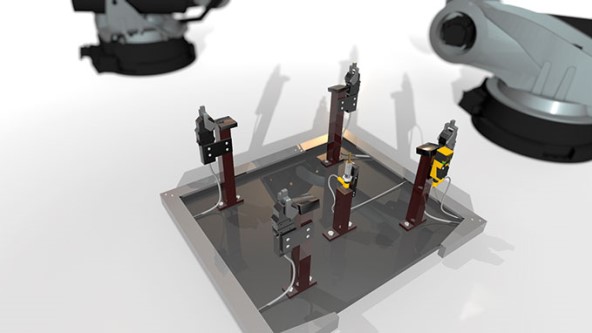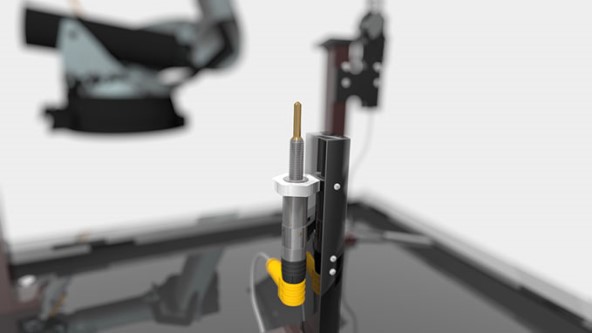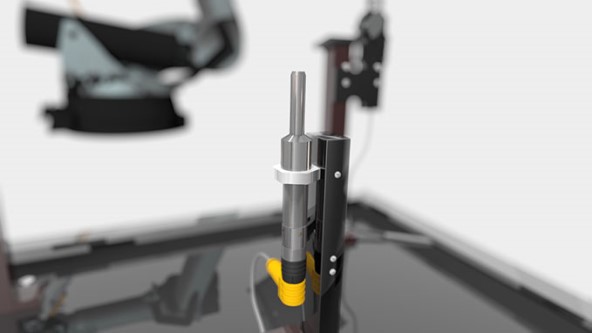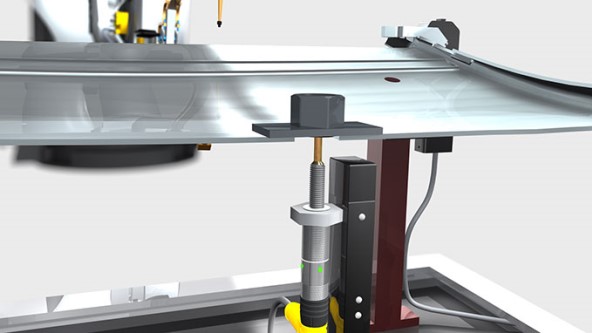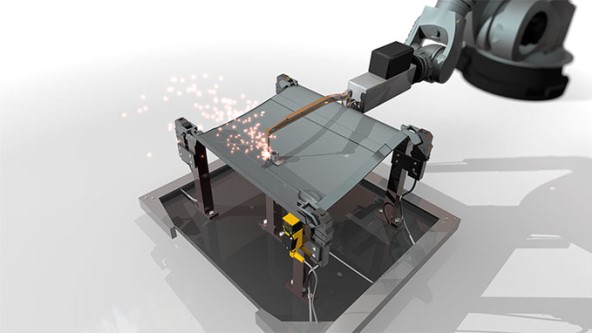Weld Nut Sensing
Location bolt with integrated sensor reliably identify and secure welding nuts and sleeves
Spacer sleeves and welding nuts are used to ensure that vehicle components such as frames, U-beams, car seats or tanks are assembled to meet the design requirements. If even one single nut or bushing is missing from its intended location, production comes to a standstill and the work goes into the scrap pile. One approach to solving the component inspection problem is the use of fiber optics which can sense the bolts laterally. However, because the weld spatter that builds up can impair the fiber optic functions and even disable them, this process is expensive and unsuitable.
Process reliable sensors
Because all optical systems are prone to malfunction, customer requests for an affordable and process reliable sensor became more and more frequent. This was incentive enough for Turck to develop a robust sensor for detecting welding nuts. An ingenious solution has been developed that not only detects metal, but also replaces the location bolt. The sensor is designed for damping caused by welding nuts and detects ferro-magnetic components such as bushings, nuts, and disks. It has a brass housing and meets the requirements for IP67 protection. LEDs reliably indicate the current switching status, including both the presence of the target as well as errors that have occurred.
Because the welding nut query takes place in a harsh environment and employees do not always work carefully, the sensor must be sufficiently protected mechanically. Protection is provided by a stainless steel centering bushing that is inserted onto the sensor and secured by the nut. Together, the sensor and the stainless steel bushing form the location bolt. The welding nut sensors can detect ferro-magnetic material through non-ferro-magnetic stainless steel bushings so that they emit a signal only in the case of magnetic metals. Because the welding nuts are made of steel, they represent an excellent target for sensors.
The new Turck sensor can be programmed to sense only the nut and not the sheet metal via pin 2 of the M12 x 1 plug-in connector and an additional teach adapter (VB2-SP1). At the press of a button, the sensor “learns” both the status of just the sheet metal as well as the status of the sheet metal and welding nut so that it can reliably detect their presence. Once the programing has been learned, it remains intact until a new teach process is initiated. The major temperature changes caused by the welding process are intercepted by temperature compensation.
- Automobile
- Mesure d'épaisseur de tôle
- Atelier de presse – Identification d'outils
- Carrosserie – Détection des écrous à souder
- Atelier de peinture – Identification de skids
- Montage final – Montage robotisé
- Montage final – Diagnostic de fuites
- Équipementiers – Système d'identification de pare-chocs
- Protection de zone pour les cellules robotisées
- Mécanique – Vérification sans contact
- Détection des corps dans la production automobile
- Inspection des becs sur des robots de soudure
- Supply of cooling lubricant in machine tools
- Controlling hydraulic pressure in pressing plants
- Measuring process pressure on scissor lifts
- Chargement manuel dans une cellule de soudage
- Détection de pièces noires sur des panneaux de porte noirs
- Détection de verre transparent sur un toit vitré
- Inspection à longue portée dans le secteur de l'assemblage automobile
- Détection de rondelles de caoutchouc sur un bloc moteur
- Détection du positionnement des pièces dans un bloc moteur
- Détection de véhicules électriques aux bornes de recharge
- Détection de voitures dans un car-wash en libre-service
- SUCCESS STORIES
- Modular Conveyor System
- RFID and I/O Modules for Safe Tool Changes
- RFID Guides AGV in Suspension Production
- IO-Link Wired Silencer Production
- Workpiece Carrier Identification in Rear Vent Production
- Weld Nut Sensing
- Traçabilité RFID
- RFID in Engine Production
- Production de pare-chocs avec système d'identification
- Solutions pour ateliers de peinture
- Welding and Assembly Sensors
- Capteurs d'angle pour systèmes d'assemblage
- Identification d'outils
- Système d'aide au choix pour la production de modules de pilotage
- Identification RFID des buses d'injection
- RFID in the Body Shop
- IO-Link Eases Differential Gear Production
- Ply Orientation Inspection
- Chimie
- Détection d'écouvillons
- Systèmes d'E/S déportés pour le traitement de signaux
- Connexion aisée des équipements de terrain
- Télésurveillance des niveaux de cuves avec le DX70
- Traitement des signaux avec un système d'E/S dans l'armoire de commande
- Séparation des signaux avec une technologie d'interface dans une armoire de commande
- Identification de raccords de tuyaux
- Surveillance efficace d'armoires sur le terrain
- Surveillance d'actionneurs quart de tour
- Planification et assemblage de solutions système
- Success Stories
- Gain d'espace dans les salles I&C grâce au système d'E/S excom
- Technologie RFID pour les zones 2 et 22
- Contrôle de test efficace
- Communications de terrain intrinsèquement sûres
- Développement d'un système de contrôle des processus en partenariat
- Système d'E/S déporté pour zones dangereuses
- Dual Valve Position Feedback
- Flexibility with Fieldbus
- Asset Management with Remote I/O
- Positionnement correct avec la technologie RFID dans la production de carbure
- Fast conversion in restricted space
- Energie
- Agro-alimentaire
- Contrôle de la hauteur de la pâte pour une mesure précise
- Contrôle de l'épaisseur de pâte dans des lamineuses
- Détection du bord avant d'une barquette en plastique
- Identification de conteneurs alimentaires
- Vérification de l'exactitude de la date et du code de lot
- Détection de la position d'une vanne
- Vérification de récipients
- Lecture de codes à barres dans un poste de dépalettisation
- Détection de coudes de tuyaux
- Vérification fiable de l'orientation des bouchons dans des espaces aseptisés
- Identification de moules à pralines
- Détection de bouteilles transparentes renversées sur un dépalettiseur
- Détection de bouteilles en plastique transparent
- Inspection d'étiquettes d'emballages alimentaires surgelés
- Accumulation de bouteilles en file indienne sur une aligneuse simple
- Détection de petits pains réfrigérés sur un convoyeur multivoie
- Success Stories
- Track and Trace in Meat Production with RFID
- Contact-free Encoder in Potato Production
- UHF RFID in Food Distribution Center
- RFID for Chocolate production
- E/S distribuées pour l'équipement de production alimentaire
- Remote I/O for Distilleries
- RFID et autoclaves
- IP67 Power Supplies for Conveyors
- Transparency in Chocolate Manufacturing
- Identification in Food Product Storage
- Equipement Mobile
- Surveillance de l'occupation d'un quai de chargement
- Surveillance sans fil de roues de train
- Lignes de distribution pour pulvérisateurs agricoles
- Indication de l'état des reach stackers à l'aide de voyants lumineux intenses
- Mesure d'angle sur un pulvérisateur agricole
- Détermination du positionnement angulaire de la flèche
- Surveillance du sens de déplacement du matériau sur une moissonneuse-batteuse
- Véhicules dans une zone de chargement
- Éclairage de compartiments de rangement des équipements sur des véhicules de pompiers
- Signalisation sans fil pour chariot élévateur
- Mesure de l'inclinaison sur deux axes pour une moissonneuse-batteuse
- Protection contre la collision sur des reach stackers
- Success Stories
- Position Measurement with RFID and Encoder
- Speed Control via Radar Sensor QT50
- La technologie RFID pour guider un chariot autoguidé dans la production de suspensions
- Modules d'E/S sur un super yacht
- Wear-free Encoder on Hopper Dredger
- I/O for Dust Suppression
- Cabinet Cooling
- Quick Disconnect Connectivity
- Automation Solutions for Extreme Cold
- Remote I/O for Cranes
- Rugged Heavy Metal Lifting
- Rollercoaster Positioning
- Mobile Machinery Solutions
- Exact Height Positioning
- Critical Angle Sensing
- Angle Sensor Detects Platform Lift
- Maintenance prédictive des pièces des machines dans une infrastructure de transport du charbon d'un port
- Pétrole et Gaz
- Emballage
- Identification de cartouches d'impression couleur
- Fonctionnement fiable des machines
- Surveillance des bouchons sur des lignes de remplissage
- Surveillance des processus de changement de produits
- Identification de bouteilles de test
- Surveillance du niveau de remplissage de café moulu
- Détection de la notice d'information dans une boîte
- Détection du niveau de remplissage des récipients
- Calcul des dimensions des boîtes en carton
- Détection de bacs de transport
- Détection de barquettes transparentes
- Vérification de la présence d'étiquettes correctes
- Détection de boîtes de différentes tailles sur un convoyeur
- Contrôle des codes à barres 2D à haute vitesse
- Détection d'emballages réfléchissants multicolores
- Mesure de diamètre d'un rouleau de film en plastique
- Positionnement de tubes à l'aide d'un repère
- Solutions pour ensacheuse verticale
- Success Stories
- Pharma
- Comptage de comprimés à haute vitesse avec un amplificateur fibre
- Surveillance d'actionneurs quart de tour
- Détection de coudes de tuyaux
- Systèmes d'E/S déportés
- Planification et construction de superskids
- Détection de liquide dans des poches pour perfusion
- Connexion aisée des équipements de terrain
- Identification de récipients cryogéniques
- Surveillance de niveau de liquide dans une grande cuve
- Identification de contenants en mouvement
- Identification de contenants en mouvement à l'aide de terminaux portables
- Identification de raccords de tuyaux pour des précurseurs
- Identification de raccords de tuyaux dans des zones stériles
- Identification de raccords de tuyaux dans des zones explosives de classe 1
- Identification de big bags et de bioréacteurs
- Identification de produits à usage unique
- Semi-conducteur
- Adhesive Detection on PCB Assembly
- Éclairage d'un outil de production dans le secteur des semi-conducteurs
- Détection du centre de plaques à l'aide du DF-G2
- Great Detail Inspection for Mobile Electronic Devices
- Error Proofing for IC Chips loaded into Pocket Tape
- Presence and Orientation of IC Chips Seated in Nests
- Detection of Hard Disks
- Multiproduct Light-Guided Assembly Station
- Success Stories


